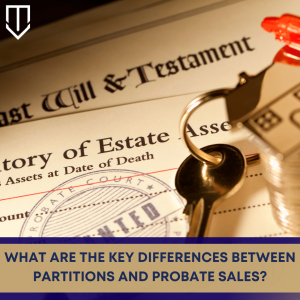 Partitions sales and probate sales are two different ways that a property can be sold. A main difference between the two is that a partition sale is ordered and overseen by the court, while a probate sale is generally overseen by a personal representative, and the court can have minimal involvement. There are also specific steps that the personal representative must take in the probate sale process under California law.
Partitions sales and probate sales are two different ways that a property can be sold. A main difference between the two is that a partition sale is ordered and overseen by the court, while a probate sale is generally overseen by a personal representative, and the court can have minimal involvement. There are also specific steps that the personal representative must take in the probate sale process under California law.
The Partitions Sale Process
Usually, partition sales are ordered by a court. This is because partition lawsuits are often brought before courts by a property owner who wants to force a sale if the parties cannot come to an agreement.
 California Partition Law Blog
California Partition Law Blog


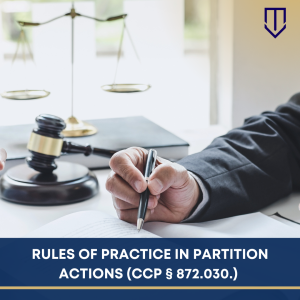 The California Code of Civil Procedure plays a pivotal role in shaping the legal landscape of civil actions. The
The California Code of Civil Procedure plays a pivotal role in shaping the legal landscape of civil actions. The  Yes. California law allows a co-owner to take out a mortgage without the other co-owners consent or knowledge.
Yes. California law allows a co-owner to take out a mortgage without the other co-owners consent or knowledge. 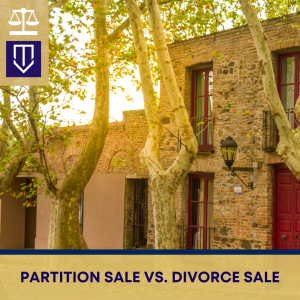 Partitions sales and divorce sales are two different ways that a property can be sold. One difference between the two is that in a partition sale, the court usually decides the proportion of ownership and how the proceeds are distributed among the owners, while in a divorce sale, the court generally must divide the property equally. Another difference is that the divorce sale process is similar to a normal real estate sale. Both sales can be determined informally among the parties or ordered by a court.
Partitions sales and divorce sales are two different ways that a property can be sold. One difference between the two is that in a partition sale, the court usually decides the proportion of ownership and how the proceeds are distributed among the owners, while in a divorce sale, the court generally must divide the property equally. Another difference is that the divorce sale process is similar to a normal real estate sale. Both sales can be determined informally among the parties or ordered by a court. 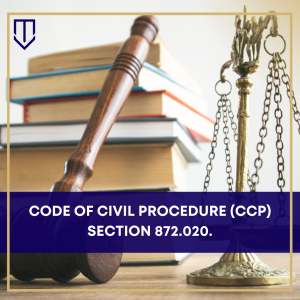 California Code of Civil Procedure section 872.020 is under Title 10.5 Partition of Real and Personal Property. This statute details the scope, or in other words, the
California Code of Civil Procedure section 872.020 is under Title 10.5 Partition of Real and Personal Property. This statute details the scope, or in other words, the  The Underwood Law Firm, which is a boutique partition firm, has offices in Sacramento, Oakland, and Newport Beach
The Underwood Law Firm, which is a boutique partition firm, has offices in Sacramento, Oakland, and Newport Beach Partitions sales and trustee sales are two different ways that a property can be sold. A main difference between the two is that a partition sale is ordered and overseen by the court, while a trustee sale is overseen by a third party in relation to foreclosure proceedings. While the third party is not beholden to a court ruling in a trustee sale, they must still follow the procedures outlined in California law.
Partitions sales and trustee sales are two different ways that a property can be sold. A main difference between the two is that a partition sale is ordered and overseen by the court, while a trustee sale is overseen by a third party in relation to foreclosure proceedings. While the third party is not beholden to a court ruling in a trustee sale, they must still follow the procedures outlined in California law.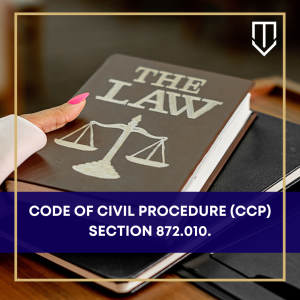 The
The  There are several provisions in real property sale agreements that can affect a party’s legal rights. One such provision is an “as-is” provision, which is often included in contracts for the sale of real property. It is important for parties to keep on the lookout for such provisions so that they are aware of their legal rights in any possible litigation.
There are several provisions in real property sale agreements that can affect a party’s legal rights. One such provision is an “as-is” provision, which is often included in contracts for the sale of real property. It is important for parties to keep on the lookout for such provisions so that they are aware of their legal rights in any possible litigation. There are two common ways an individual can own property: (1) as a tenant in common or (2) as a joint tenant. In California, there is a presumption that the co-owners of a piece of property are tenants in common unless the deed expressly states that the co-owners are joint tenants.
There are two common ways an individual can own property: (1) as a tenant in common or (2) as a joint tenant. In California, there is a presumption that the co-owners of a piece of property are tenants in common unless the deed expressly states that the co-owners are joint tenants.